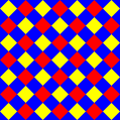Top Qs
Timeline
Chat
Perspective
Alternated hypercubic honeycomb
From Wikipedia, the free encyclopedia
Remove ads
In geometry, the alternated hypercube honeycomb (or demicubic honeycomb) is a dimensional infinite series of honeycombs, based on the hypercube honeycomb with an alternation operation. It is given a Schläfli symbol h{4,3...3,4} representing the regular form with half the vertices removed and containing the symmetry of Coxeter group for n ≥ 4. A lower symmetry form can be created by removing another mirror on an order-4 peak.[1]
 An alternated square tiling or checkerboard pattern. |
 An expanded square tiling. |
 A partially filled alternated cubic honeycomb with tetrahedral and octahedral cells. |
 A subsymmetry colored alternated cubic honeycomb. |
The alternated hypercube facets become demihypercubes, and the deleted vertices create new orthoplex facets. The vertex figure for honeycombs of this family are rectified orthoplexes.
These are also named as hδn for an (n−1)-dimensional honeycomb.
Remove ads
See also
References
Wikiwand - on
Seamless Wikipedia browsing. On steroids.
Remove ads


